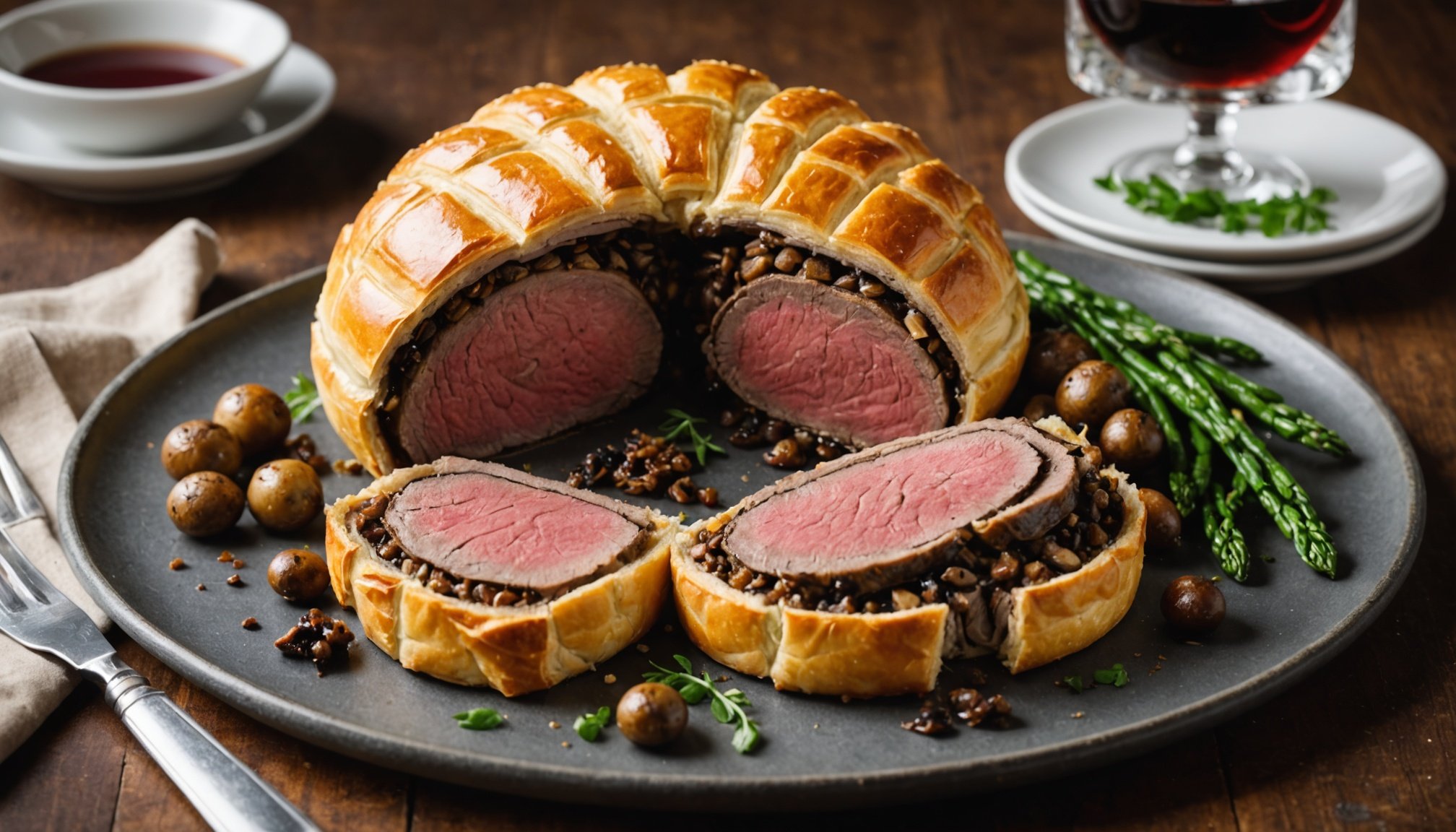Understanding Beef Wellington
Beef Wellington is a renowned dish in gourmet cooking, celebrated for its sophisticated culinary techniques. This classic British preparation involves a rich history and an intricate layering of flavors. Historically, the dish can be traced back to the 19th century and is believed to have been named after the Duke of Wellington, though its exact origins remain a subject of culinary debate. The evolution of this recipe has seen the introduction of unique ingredients and methods of preparation, constantly enhancing its appeal.
The dish’s significance lies in the harmonious combination of its components, each playing a crucial role in creating the overall taste profile. At its heart is a perfectly cooked beef tenderloin, encased in layers that typically include a mushroom duxelles and sometimes, a thin slice of prosciutto or pâté. These elements are enveloped in a golden puff pastry, which not only seals in the flavors but also provides a delightful, flaky contrast to the tender interior.
Topic to read : What Makes British Cuisine Unique Compared to Other Cuisines?
Mastery of Beef Wellington requires an understanding of these components and the skill to balance culinary techniques, ensuring every bite delivers an exquisite gastronomic experience.
Ingredients for Gourmet Beef Wellington
When creating a gourmet Beef Wellington, the ingredient list plays a pivotal role in the dish’s success. The primary focus is on sourcing high-quality ingredients, starting with the beef tenderloin. This cut is prized for its inherent tenderness and rich flavor, crucial for the centerpiece of this classic dish.
In the same genre : What Makes British Cuisine Unique Compared to Other Cuisines?
Additionally, selecting the best mushrooms for the duxelles is essential. Opt for varieties like cremini or shiitake, which offer an earthy depth of flavor. As with any culinary techniques, the quality of your ingredients will directly impact the final product.
Beyond beef and mushrooms, other essential components include:
- Puff pastry: Delivers the flaky, buttery crust that encases the Wellington.
- Prosciutto or pâté: Thin slices add an extra layer of flavor and richness.
- Dijon mustard: Lightly brushed over the beef for a subtle tang.
For those exploring variations, consider adding liver pâté for extra depth or using truffle oil for a luxurious twist. Remember, in gourmet cooking, each ingredient, whether core or optional, should contribute harmoniously to the overall palate and enhance the dish’s elegance.
Preparing Savory Mushroom Duxelles
Creating an exceptional mushroom duxelles is an essential step in making a successful Beef Wellington. This component adds an earthy richness and a depth of flavor that complements the beef. To make the best duxelles, begin by finely chopping high-quality mushrooms like cremini or shiitake, known for their vibrant taste and texture.
Cooking techniques are pivotal. Start by sautéing the chopped mushrooms in a preheated pan with a small amount of butter or oil. This helps to draw out moisture, concentrating the flavors. Continuously stir to prevent burning while allowing the mushrooms to achieve a golden brown hue. It’s crucial to control the heat, maintaining a temperature that evicts moisture yet avoids browning too quickly.
To enhance flavor, incorporate finely diced shallots and fresh herbs, such as thyme, during cooking. A splash of white wine or truffle oil can elevate the mixture further. This delicate balance of ingredients and cooking techniques ensures the duxelles contribute boldly to the Beef Wellington.
Once the duxelles reach a pâté-like consistency, they’re ready to cool and be layered meticulously over the beef, adding a sumptuous note that makes the dish unforgettable.
Assembling the Beef Wellington
Creating a delectable Beef Wellington requires mastering the art of assembling Wellington with precision. This involves the crucial process of layering flavors and ensuring the pastry wrapping is flawless.
Begin by spreading the savory mushroom duxelles over the prosciutto or directly on the beef tenderloin. This layering is vital for infusing the tender meat with rich, earthy notes. The next step is coating the beef with a thin layer of Dijon mustard, which adds a subtle tanginess and helps adhere the components firmly.
When it comes to pastry wrapping, careful attention to detail is essential. Roll out the puff pastry on a floured surface to the desired thickness, ensuring it’s large enough to envelop the beef entirely. Place the layered beef on the pastry, fold the ends, and seal the edges thoroughly to prevent any leakage during baking. Aesthetic neatness is key, as any gaps may compromise the exquisiteness of the final dish.
Lastly, brush the pastry with a beaten egg for a shiny, golden finish. The importance of sealing the pastry can’t be overstressed – it locks in moisture and flavors, offering a delightful contrast between the succulent beef and flaky pastry.
Cooking Techniques for Beef Wellington
Successfully cooking Beef Wellington requires understanding precise cooking methods to achieve the desired meat doneness. Start by preheating your oven to 200°C (400°F), which provides the ideal environment for a balanced cook through the layers. The goal is to attain a perfect medium-rare, bringing out the delicate flavors of the beef. Insert a meat thermometer into the center of the tenderloin for accuracy: a temperature of 54-57°C (130-135°F) indicates medium-rare.
Be aware of common pitfalls like uneven cooking or a soggy base. Avoid such issues by ensuring the puff pastry isn’t overly thick and brush a layer of egg wash around the edges to promote even browning. This simple trick enhances the dish’s visual appeal and texture.
Monitor cooking closely; adjust the oven temperature if the pastry browns too quickly. Remember that beef should rest post-oven, allowing juices to redistribute. This sets the succulent meat, ensuring each serving is as delightful as the first. Seasoned chefs recommend brushing the finished dish with melted butter for added sheen, elevating the gourmet presentation. These steps transform Beef Wellington from a dish to a culinary masterpiece.
Presentation and Serving Suggestions
Presentation is crucial when serving Beef Wellington to not only highlight your culinary skills but also to enhance the dining experience. Begin by slicing the Wellington into thick, even portions to showcase its layers. Use a sharp knife to maintain the integrity of the flaky pastry and tender beef.
For elegant plating, consider arranging the slices in a fan-like pattern. Accompany your Wellington with visually appealing sides such as vibrant green beans or glazed carrots. These not only complement the flavours but offer a pop of colour.
To elevate your presentation, consider a light drizzle of rich jus or a red wine reduction around the plate. This not only adds a layer of depth to the dish’s palate but also underscores the gourmet cooking essence.
Garnishing with fresh herbs like rosemary or thyme can add both fragrance and a touch of green freshness, making your dish look effortlessly classy. If you’re keen to impress further, serve alongside a creamy potato mash or a delicate salad, both of which balance the richness of the Wellington.
Remember, successful presentation enhances both the visual and gustatory appeal, transforming a meal into a memorable gourmet experience.
Tips for Success and Variations
Achieving culinary excellence with Beef Wellington involves mastering certain cooking tips that can enhance both the cooking process and the final outcome. An essential tip is ensuring all ingredients, particularly the beef and pastry, are at room temperature before assembly to promote even cooking. Chilling the assembled Wellington in the refrigerator for 15-20 minutes before baking helps maintain its shape and improves the pastry’s flaky texture.
For those seeking variations, there are numerous options to cater to dietary preferences or add a unique twist. Substitute traditional puff pastry with a gluten-free version to accommodate dietary needs. For a lighter meal, consider replacing beef with salmon, introducing an alternative protein source while still capturing the essence of the dish.
Avoid common mistakes such as over-seasoning. The beef’s natural taste should shine, complemented rather than overwhelmed by the surrounding flavors. Lastly, employ a digital thermometer during baking to monitor the meat’s internal temperature accurately, an invaluable tool in avoiding overcooking.
Experimenting with culinary advice from expert chefs can personalize your Wellington, making it a testament to your unique style while adhering to the principles of gourmet cooking.


